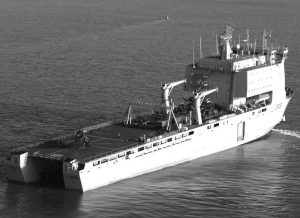- Author
- Smith, John, Cmdr, RAN (RTD)
- Subjects
- Ship design and development, Ship histories and stories, Letter to the Editor
- Tags
-
- RAN Ships
- None noted.
- Publication
- December 2011 edition of the Naval Historical Review (all rights reserved)
In early 2011, it was announced the RAN would purchase RFA Largs Bay, a six year old Landing Ship Dock (LSD) now surplus to British requirements. The purchase price was approximately $A100 million and she was to be operational in Australia from 2012. It was also stated that ‘…further expenditure is to occur only in exceptional circumstances’.
The reason for the purchase is to fill the gap in Australia’s amphibious capabilities resulting from the decommissioning of HMA Ships Kanimbla and Manoora, problems with HMAS Tobruk, and pending the operational availability of the new LSDs, HMA Ships Adelaide and Canberra expected to be in service from 2014.
One of the associated decisions relating to this purchase was which name was she to be commissioned on entering the RAN. For guidance, the current naming policy is laid down in Defence Instructions (Navy) ADMIN 4-4 dated 27 July 2000, the relevant sections state as follows:
3 (d). Amphibious ships may be named after Australian combined/amphibious operations, battles, contiguous seas or amphibious ships of the past.
- The foregoing principles are for guidance only and do not exclude the wider use, across ship types, of other types of names.
On l3 August 20ll, the Prime Minister and the Minister of Defence announced: ‘…that the ex-Royal Fleet Auxiliary Landing Ship Dock Largs Bay is to commission into the Royal Australian Navy as HMAS Choules.’ There were obviously valid reasons for this choice which does not comply with the primary criteria specified above for naming amphibious ships.

From many comments resulting from this announcement, it is obvious that the decision was far from universally accepted by naval aficionados. However, the choice has been made and she will become HMAS Choules. It is interesting to contemplate what alternative names could have been considered. Soon after the purchase was announced, it was strongly rumoured that she would be named HMAS Jervis Bay. This would continue the practice of having two previous support ships with this name. Additionally, Jervis Bay has a strong naval geographical connection and was also the name of a very famous armed merchant cruiser in World War II.
HMS Jervis Bay (ex SS Jervis Bay) was sunk by overwhelming odds in 1940 whilst protecting a convoy from the German pocket battleship Admiral Scheer. Her Commanding Officer, Acting Captain E.S.F. Fegen RN was posthumously awarded the Victoria Cross for this courageous action. As a further Australian connection, he was the Commander of the Royal Australian Naval College from January 1928 to August 1929 whilst the College was still at Jervis Bay. However, why change the name Largs Bay at all? There are many precedents in the history of the RAN for retaining the name when an HM Ship is recommissioned as an HMA Ship including the following: HMA Ships Anzac, Duchess, Encounter, Fantome, Geranium, Mallow, Marguerite, Penguin, Pioneer, Psyche, Quadrant, Quality, Queenborough, Shropshire, Stuart, Vampire, Vendetta, Voyager, Waterhen, and Vengeance.
Perhaps surprisingly, Largs Bay has many Australian connections which would justify its name as an HMA Ship. Firstly and geographically there is a Largs Bay at Adelaide. Secondly, the previous ship with the name SS Largs Bay had strong Australian affiliations. She was built in l92l by William Beardmore on the order of the Australian Government for the Commonwealth Government Line of Steamers for the England/Australia run. She was subsequently sold to the White Star Line and then the Aberdeen and Commonwealth Line remaining on the same run. Many Australians would have been carried by her during this seventeen year period. With the outbreak of WW II1, she was requisitioned as a British troop ship. In that capacity, in August 1945 she transported 470 Australian ex prisoners of war from Singapore home to Brisbane. Thirdly, SS Largs Bay had five sister ships of which one was Jervis Bay referred to earlier.
Would HMAS Largs Bay have been a sensible choice of name? At least, it would have appealed to the bean counters following the directive that ‘…further expenditure is to occur only in exceptional circumstances’. Meanwhile many happy commissions to HMAS Choules.
John Smith
An article on the late CPO Claude Choules is to be found in the June 2011 edition of the Review. The writer might also have mentioned the continuation of the ex-merchant ships names of Kanimbla and Manoora. (Ed.)




